In the second part of this series, Mark Nicholls journeys across the hilltops of Sicily and discovers more about Europes most active Volcano…
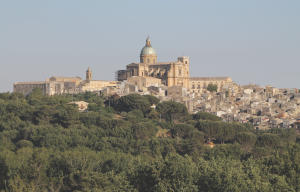
Read Part 1 here
Olives and vines
Journeying across Sicily takes you through a landscape of rolling hillsides lined with olives and vines, distant red patches of poppies with isolated hilltop castles visible in the distance and beautiful towns. One such town, in the heart of Sicily, is Piazza Armerina. It may have seen better days but simply oozes character.
As afternoon mellows into early evening and the light softens, the façade of the Duomo glows a shade of caramel, while the statue of Marco Trigona before the edifice reaches out a hand to the huge bronze doors and the building he designed. From a distance, the church shines like a beacon while the medieval town falls away, with red tiled roofs creating a patchwork vista.
A few miles away is the Villa Romana del Casale, arguably the most impressive Roman site on Sicily, with mosaics that were hidden and preserved by a mudslide triggered by the erupting Mt Etna. The complexity, the colours and the detail in the stories is phenomenal; they portray tales from across the Roman Empire, with hunting scenes and the so-called ‘bikini girls’, showing young Roman women practising athletic sports, being the best known.
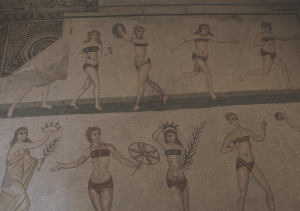
The journey to Erice passes the glistening salt pans of Trapani set against a backdrop of windmills and the small island of Mozia. Now peaceful, it gives little hint of the brutal carnage that occurred here in the 3rd century BC when the Romans laid siege and then slaughtered the resident Carthaginian community. The switchback ascent to Erice is impressive, up to what is now a medieval town, yet, as with most Sicilian strongholds, has a history reaching back two millennia or more, to a time when the Greeks and Romans built temples and amphitheatres; and then Saracen invaders established mosques.
Visitors are struck by the solidity of Frederick III’s watchtower, which somewhat overshadows the simple exterior of the 14th-century Cathedral of Our Lady of the Assumption. But allow yourself to be enticed within, to the bright interior, to where a medieval cake-maker has seemingly been let loose to decorate the nave ceiling with giant piped icing: pale cream, unbelievably ornate, and stunningly beautiful in execution. Nearby is the real thing: a cake shop which claims to be Sicily’s most famous, Maria Grammatico, where you can buy delicious confectionery.
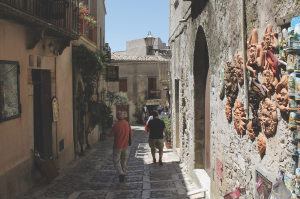
Erice’s cobbles are shiny with footfall, leading to small shops and stalls selling pottery, jewellery, linen, wood carvings and souvenirs, lovely cafés and restaurants and the castle and gardens with spectacular views over the landscape and shoreline below. All across the hilltop town are landmarks of centuries past: the grey edifice of a cathedral, watchtowers, fortified walls with arched gates, churches tucked away into quiet corners, and a strategic castle.
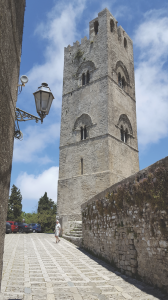
Through alleys, flowers tumble over balconies, laundry flaps from upper windows and low doorways appear out of nowhere. These are the characteristics of Erice, sitting 750 metres above the Mediterranean shore, a bastion of history on this island criss-crossed with hilltop gems and fortified towns.
Agrigento and Mount Etna
On the southern coast, Agrigento, a town made famous in more recent times as the setting for the Inspector Montalbano books and the subsequent TV series, was once the site of 15 temples arcing around the modern city. Today, two dominate: the temple Hera Lakinia, dating from 460 BC, and the Temple of Concordia.
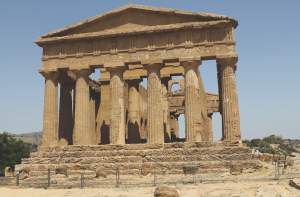
Agrigento expert Michele Gallo says, “The Temple of Concordia was the last temple built, in 435 BC, and was designed to look perfect to the eye from a distance. To achieve this effect, the columns lean inwards and slant so when you are far away they look straight and there is also a ‘bulge’ in the columns about a third of the way up. The site was chosen by Greek settlers because of its strategic position, the fertility of the land, and its being ideal for trade with the sea close by for the export of wheat, olive oil and wine.”
With a population of 200,000 – it was the third largest Greek city after Athens and Syracuse – the temples were built by 30,000 Carthaginian slaves over a mere 74 years. For those with a passion for Doric temples, the Temple of Segesta is colossal, solid and simply fabulous – yet no visit to Sicily would be complete without ascending Mt Etna…
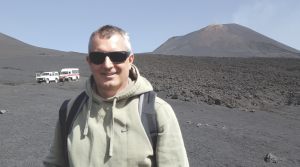
Etna is Europe’s most active volcano, with frequent eruptions that constantly shape and re-shape the mountainside. Yet a quarter of Sicily’s population lives in its shadow, regarding her as more maternal than menacing in the way she oversees the island, giving the land fertility, influencing the weather – and attracting tourists. With wisps of smoke drifting from the summit at 3,330 metres, the influence is everywhere – such as in the fishing town of Cefalù, where steps lead down to a medieval laundry where the river flows through stone channels with clothes scrubbed on slabs for lather – inevitably, made of lava.
You can get to within a few hundred feet of the summit, depending on the risk of eruption, where all around the solidified lava fields and gritty, cratered terrain have the appearance of a shifting moonscape as, with each eruption, the lava streams re-shape the form of this volcano. From its slopes, Mt Etna also offers the most spectacular views of the Sicilian landscape, where all who have passed through have left their mark.
Getting there
Mark Nicholls travelled on Explore’s eight-day Classical Sicily trip. Costing from £1,089 per person, it includes return flights, seven nights’ bed and breakfast hotel accommodation, transport and the services of an Explore leader, driver and local guides.
For more information call 01252 884223, 01252 883681 or visit Explore here
Accommodation
Guests on the Explore trip stay in three- and four-star accommodation, including the centrally located Hotel Politeama
in Palermo (hotelpoliteama.com) and the delightfully quirky Hotel La Riva (hotellariva.com) on the seafront in Giardini Naxos, with its irresistibly relaxing seaside ambience and character, and with Etna looming out of the distance.
